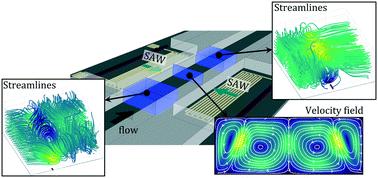Our official English website, www.x-mol.net, welcomes your
feedback! (Note: you will need to create a separate account there.)
On the acoustically induced fluid flow in particle separation systems employing standing surface acoustic waves – Part II
Lab on a Chip ( IF 6.1 ) Pub Date : 2022-04-29 , DOI: 10.1039/d2lc00106c Sebastian Sachs 1 , Christian Cierpka 1, 2 , Jörg König 1
Lab on a Chip ( IF 6.1 ) Pub Date : 2022-04-29 , DOI: 10.1039/d2lc00106c Sebastian Sachs 1 , Christian Cierpka 1, 2 , Jörg König 1
Affiliation

|
Particle separation using surface acoustic waves (SAWs) has been a focus of ongoing research for several years, leading to promising technologies based on Lab-on-a-Chip devices. In many of them, scattering effects of acoustic waves on suspended particles are utilized to manipulate their motion by means of the acoustic radiation force (FARF). Due to viscous damping of radiated waves within a fluid, known as the acoustic streaming effect, a superimposed fluid flow is generated, which additionally affects the trajectories of the particles by drag forces. To evaluate the influence of this acoustically induced flow on the fractionation of suspended particles, the present study gives a deep insight into the pattern and scaling of the resulting vortex structures by quantitative three-dimensional, three component (3D3C) velocity measurements. Following the analysis of translationally invariant structures at the center of a pseudo-standing surface acoustic wave (sSAW) in Part I, the focus in Part II turns to the outer regions of acoustic actuation. The impact of key parameters on the formation of the outer vortices, such as the wavelength of the SAW λSAW, the channel height H and electrical power Pel, is investigated with respect to the design of corresponding separation systems. As a result of large gradients in the acoustic fields, broadly extended vortices are formed, which can cause a lateral displacement of particles and are thus essential for a holistic analysis of the flow phenomena. The interaction with an externally imposed main flow reveals local recirculation regions, while the extent of the vortices is quantified based on the displacement of the main flow.
中文翻译:

关于采用驻表面声波的粒子分离系统中的声学诱导流体流动——第二部分
多年来,使用表面声波 (SAW) 进行粒子分离一直是持续研究的重点,从而产生了基于芯片实验室设备的有前景的技术。在其中许多中,声波对悬浮粒子的散射效应被用来通过声辐射力(F ARF)。由于流体中辐射波的粘性阻尼(称为声流效应),会产生叠加的流体流动,这还会通过阻力影响粒子的轨迹。为了评估这种声学诱导的流动对悬浮颗粒分馏的影响,本研究通过定量三维三分量 (3D3C) 速度测量深入了解所产生的涡流结构的模式和比例。在第一部分分析了伪驻表面声波 (sSAW) 中心的平移不变结构之后,第二部分的重点转向声学驱动的外部区域。关键参数对外涡流形成的影响,如 SAW 的波长λSAW,通道高度H和电功率P el,针对相应分离系统的设计进行了研究。由于声场中的大梯度,形成了广泛扩展的涡流,这会导致粒子的横向位移,因此对于流动现象的整体分析至关重要。与外部施加的主流的相互作用揭示了局部再循环区域,而涡流的范围是根据主流的位移来量化的。
更新日期:2022-04-29
中文翻译:

关于采用驻表面声波的粒子分离系统中的声学诱导流体流动——第二部分
多年来,使用表面声波 (SAW) 进行粒子分离一直是持续研究的重点,从而产生了基于芯片实验室设备的有前景的技术。在其中许多中,声波对悬浮粒子的散射效应被用来通过声辐射力(F ARF)。由于流体中辐射波的粘性阻尼(称为声流效应),会产生叠加的流体流动,这还会通过阻力影响粒子的轨迹。为了评估这种声学诱导的流动对悬浮颗粒分馏的影响,本研究通过定量三维三分量 (3D3C) 速度测量深入了解所产生的涡流结构的模式和比例。在第一部分分析了伪驻表面声波 (sSAW) 中心的平移不变结构之后,第二部分的重点转向声学驱动的外部区域。关键参数对外涡流形成的影响,如 SAW 的波长λSAW,通道高度H和电功率P el,针对相应分离系统的设计进行了研究。由于声场中的大梯度,形成了广泛扩展的涡流,这会导致粒子的横向位移,因此对于流动现象的整体分析至关重要。与外部施加的主流的相互作用揭示了局部再循环区域,而涡流的范围是根据主流的位移来量化的。











































 京公网安备 11010802027423号
京公网安备 11010802027423号